Endure: Mind, Body and the Curiously Elastic Limits of Human Performance
£6.80£10.40 (-35%)
‘This book is AMAZING!’ – MALCOLM GLADWELL
‘If you want to gain insight into the mind of great athletes, adventurers, and peak performers then prepare to be enthralled by Alex Hutchinson’s Endure.’ – BEAR GRYLLS
How high or far or fast can humans go? And what about individual potential: what defines a person’s limits? From running a two-hour marathon to summiting Mount Everest, we’re fascinated by the extremes of human endurance, constantly testing both our physical and psychological limits.
In Endure Alex Hutchinson, Ph.D., reveals why our individual limits may be determined as much by our head and heart, as by our muscles. He presents an overview of science’s search for understanding human fatigue, from crude experiments with electricity and frogs’ legs to sophisticated brain imaging technology. Going beyond the traditional mechanical view of human limits, he instead argues that a key element in endurance is how the brain responds to distress signals―whether heat, or cold, or muscles screaming with lactic acid―and reveals that we can train to improve brain response.
An elite distance runner himself, Hutchinson takes us to the forefront of the new sports psychology – brain electrode jolts, computer-based training, subliminal messaging – and presents startling new discoveries enhancing the performance of athletes today, showing us how anyone can utilize these tactics to bolster their own performance – and get the most out of their bodies.
Read more
Additional information
| Publisher | HarperCollins (7 Feb. 2019) |
|---|---|
| Language | English |
| Paperback | 320 pages |
| ISBN-10 | 0008308187 |
| ISBN-13 | 978-0008308186 |
| Dimensions | 12.9 x 2 x 19.8 cm |

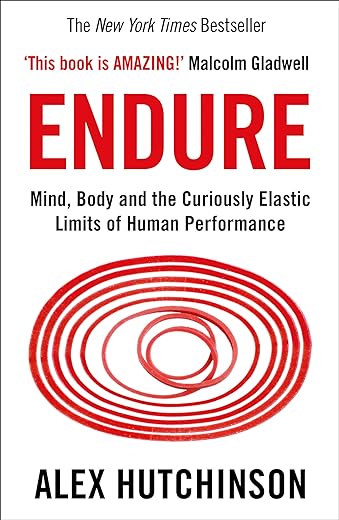
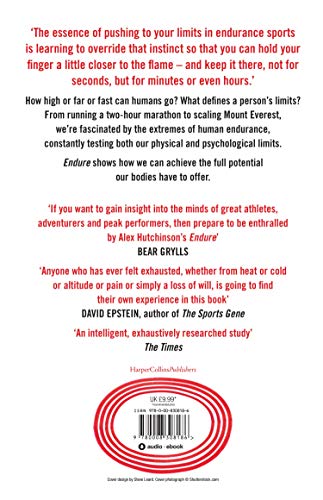
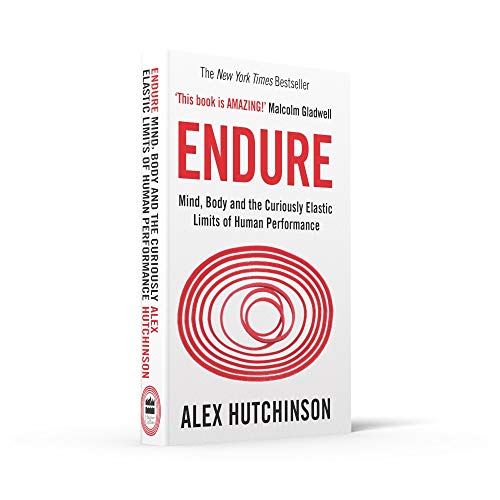

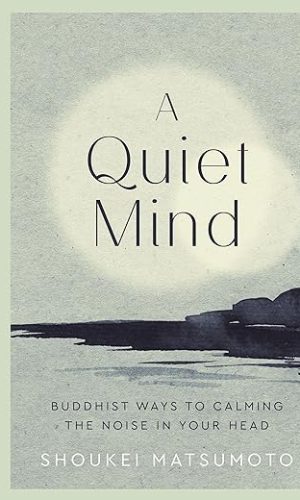


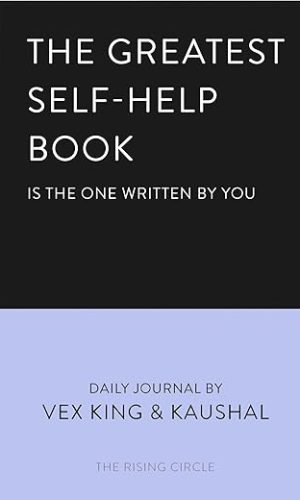

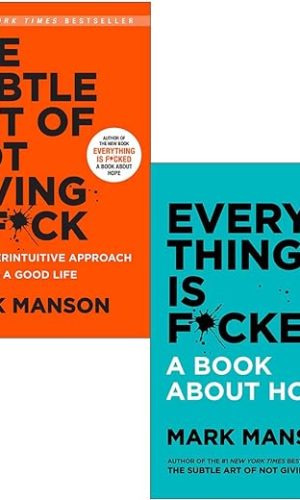
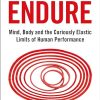
by S. Loddick
I bought this book for holiday reading as a distinctly amateur and average runner, but aware that sometimes it is my mind that is my biggest weakness \ limit.
There is no magic bullet contained within the book, but there are plenty of takeaways that will make you think, and perhaps change the way you think, about being an endurance athlete.
It’s easy reading, but will it make me into a better athlete \ runner. Well maybe, because it reminded me that the foundation of being a better runner is training and resting. A lot of the rest is the icing on the cake, but good icing can make a cake.
by Ian Mostyn
A great book for endurance athletes. Anyone thinking about an Ironman or marathon should give this a read first
by Vlad
Solid writing, with lots of factual data from extreme human endurance cases in the wild. However, gets quite hard to read after first half of the book. All the experiments/incidents/deaths stories are a little grim and dark, maybe by intention but not very enjoyable for me. If you want more down-to-earth read about endurance sports, I recommend Rich Roll’s “Finding Ultra”.
by Ron Immink
When you read books about leadership, athletes and Navy Seals, you understand that many things are possible with the right mindset. Hence “Endure: Mind, Body and the Curiously Elastic Limits of Human Performance”
Endurance
Reaching the limits of endurance is a concept that seems yawningly obvious until you actually try to explain it. He defines endurance as “the struggle to continue against a mounting desire to stop.” And the mind plays a huge role. However, the brain’s role in endurance is, perhaps, the single most controversial topic in sports science.
Not dead, could have done more
He quotes a coach’s observation about a second-place Olympic marathoner jogging around the track waving his country’s flag. “Do you notice he’s not dead?” he asked. “It means he could have run faster.”
Pacing
Studies have found that we can’t avoid pacing ourselves: your “maximum” force depends on how many reps you think you have left. It also turns out that, whether it is heat or cold, hunger or thirst, or muscles screaming with the supposed poison of “lactic acid,” what matters in many cases is how the brain interprets these distress signals.
Body and mind
With the rise of sophisticated techniques to measure and manipulate the brain, researchers are finally getting a glimpse of what’s happening in our neurons and synapses when we are pushed to our limits. They found that brain and body are fundamentally intertwined, and to understand what defines your limits under any particular set of circumstances you have to consider them both together.
Smiling
The British military has funded studies of computer-based brain training protocols to enhance the endurance of its troops, with startling results. Even subliminal messages can help or hurt your endurance: a picture of a smiling face flashed in 16-millisecond bursts, boosts cycling performance by 12 per cent compared to frowning faces.
Frame of mind
Another British study in 2012 showed that cyclists in a heat chamber went 4 per cent faster when the thermometer was rigged to display a falsely low temperature (26 instead of 32 degrees Celsius). The right frame of mind, in other words, allows you to push beyond your usual temperature limits.
You are operating at 65%
The brain’s task is to protect you. It is a survival machine. Read “Solve for happy“. Which is why pacing instinct is not entirely voluntary: your brain forces you to slow down, long before you’re in real physiological distress. So the brain plays a role in defining the limits of endurance. Most of us can summon about 65 per cent of our theoretical maximum strength.
Switch of the safety switch
For example, the fact that people can dive to three hundred feet or hold their breath for nearly twelve minutes tells us that oxygen’s absolute limits aren’t quite as constrictive as they feel, that we are protected by layer upon layer of reflexive safety mechanisms.
Change the settings
Average strength increases of 26.5 per cent after hypnosis. So the question is how can you change the settings of your brain? Can you gain access to at least some of the emergency reserve of energy that your brain protects? There’s no doubt that some athletes are able to wring more out of their bodies than others, and those who finish with the most in reserve would dearly love to be able to reduce that margin of safety. But is this really a consequence of the brain’s subconscious decision to throttle back muscle recruitment or is it, as a rival brain-centred theory of endurance posits, simply a matter of how badly you want it?
The science of anticipatory regulation
They found that the importance of any underlying physiological signal depends in part on how your brain receives and interprets it. The science of “anticipatory regulation”: getting your brain to use the knowledge that is gathered consciously, like an impending dive or a looming finish line, to activate or deactivate safety mechanisms that are otherwise purely unconscious. Endurance as second stage thinking. Managing a cognitive trait called response inhibition, which involves overriding your initial instinct, as a key.
The other things
That does not mean that you can ignore simple things such as temperature, oxygen, lactate, calories, proteins, fat, dehydration, pain tolerance and mostly effort.
So how do you improve your response inhibition and effort?
Manage perceived exertion
Pain training (apparently pain is fundamentally a subjective, situation-dependent phenomenon)
Train the brain to become more accustomed to mental fatigue
Test your capabilities, whatever you’ve done before, you can do again plus a little more
Create placebo effects
Create lucky charms
Apply acts of random kindness
Use drugs
Apply virtual reality (running against yourself)
Training in resilience
Training in non-judgmental self-awareness
Training in mindfulness
Again performance and mindfulness meet
All the techniques you find in most self-help books. Mind techniques to become a better athlete (or CEO). Teaching athletes that they can do more than they think they can. Knowing that their fiercest opponent will be their own brain’s well-meaning protective circuitry.
In short, there is more in there, if you’re willing to believe it.
by Gemma
“I remind myself that my fiercest opponent will be my own brain’s well-meaning protective circuitry.”
I wanted to read this book ahead of the upcoming Turf Games event as I know that mental strength is just as, if not more, important than physical strength in getting us through the challenges we set ourselves.
It provided interesting stories of different kinds of athletes: runners, divers, cyclists, climbers. Travelling through chapters on pain, muscle, oxygen, heat, thirst and fuel.
Effort, belief and determination. “There’s more in there- if you’re willing to believe it.”
“The struggle to continue against a mounting desire to stop”- Samuele Marcora.
by Phloebus
This is a good and fairly easy read. In some of the more in-depth sections you may have to concentrate a bit, but that’s no bad thing!
The book really asks two questions:
1) What stops us from running ourselves to death?
2) …And how can we push ourselves a bit closer?
The general idea is that our brain acts as a controller and makes sure that although we can push ourselves into the red zone, we stop before we explode.
The degree to which this is conscious or subconscious and how this management information is shunted about the body makes up quite a lot of the book.
The other part is how we can push ourselves closer to our absolute limit. The author covers everything from the benefits of motivational words to playing metabolic tricks on the body and running electric currents through the brain.
Unfortunately I came away a bit unsatisfied. The author himself points out that there seem to be a whole of ways to get a 1-3% boost. But these are not cumulative; using three of them simultaneously doesn’t give a 9% boost…
The conclusion, then, is that the body holds back a bit more than 3% in reserve. You can access this various ways, but there simply isn’t much else available!
(I guess that’s not a criticism of the book as such, it’s just a pity that the conclusion ends up being a bit banal…)
by Phil R
I really enjoyed this book. It’s not a running book, more a study in the psychology and physiology of endurance and the interconnections between the two. Recommended.